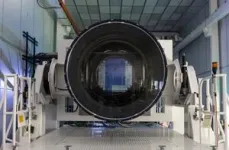(Press-News.org)
California, a state known for its aggressive greenhouse gas reduction policies, is ironically the nation’s greatest emitter of one: sulfuryl fluoride.
As much as 17% of global emissions of this gas, a common pesticide for treating termites and other wood-infesting insects, stem from the United States. The majority of those emissions trace back to just a few counties in California, finds a new study led by Johns Hopkins University.
“When we finally mapped it out, the results were puzzling because the emissions were all coming from one place,” said co-author Scot Miller, an assistant professor of environmental health and engineering at Johns Hopkins who studies greenhouse gases and air pollutants. “Other greenhouse gases like carbon dioxide and methane are found everywhere across the U.S. On our sulfuryl fluoride map, only California lit up like a Christmas tree.”
Miller and lead author Dylan Gaeta, a PhD candidate at Johns Hopkins, analyzed more than 15,000 air samples collected between 2015 and 2019 by NOAA Global Monitoring Laboratory scientists. The researchers factored in wind speed, direction, and other meteorological variables to trace the chemicals back to their point of origin.
The team found 60-85% of sulfuryl fluoride emissions in the U.S. come from California, primarily Los Angeles, Orange, and San Diego counties, despite California being a national leader in reducing greenhouse gas emissions, including publishing a comprehensive plan to achieve net-zero emissions by 2045.
“We can now show not only where but also how and why this gas is being emitted,” Gaeta said. “In order to get to net-zero emissions, we need a complete inventory of what greenhouse gases are out there.”
The findings published today in Communications Earth & Environment.
First approved by the U.S. Environmental Protection Agency for use as a pesticide in 1959, sulfuryl fluoride gained popularity after countries around the world agreed to phase out more reactive fumigants that were depleting the ozone layer, the researchers said.
Because California has kept thorough records of pesticide use, the team was able to attribute the vast majority, roughly 85% of the state’s sulfuryl fluoride emissions, to structural fumigation—the practice of sealing an infested structure with an airtight tent, pumping gas into the tent to eradicate the pests, and afterward venting the gas directly into the atmosphere. Roughly 15% came from agricultural and commodities fumigation.
Once emitted, the gas spreads and stays for more than 40 years in the atmosphere, where it contributes to global warming by trapping heat and sending it back down to the Earth’s surface, the researchers said. Average concentrations of sulfuryl fluoride in the atmosphere are low; however, humans have been emitting the man-made gas for decades at a rate faster than it can breakdown naturally.
“Without some form of intervention, sulfuryl fluoride is going to keep accumulating in our atmosphere. For most greenhouse gases, California has been very intentional about how it’s going to reduce emissions,” Gaeta said. “This one has slipped under the radar.”
Efforts to reduce greenhouse gas emissions generally focus on carbon because it poses the greatest threat to global warming. But, Miller said, researchers are working to get a more complete picture of the risks from other greenhouse gases.
Sulfuryl fluoride is one of the few treatments to rid buildings of drywood termites, a common regional pest that can form colonies in high, hard-to-reach parts of wooden structures. It’s also used at shipping ports to kill pests before they can hitch a ride to other parts of the world.
“It really is a double-edged sword. Sulfuryl fluoride is less harmful than the banned fumigants, but it also contributes to global warming,” Miller said. “California’s track record shows that it’s been looking at out-of-the-box, creative ways to reduce its greenhouse gas emissions. I think knowing better what the emissions are and what impact they have will give the state the information it needs to help holistically develop greenhouse gas reduction strategies.”
The researchers shared findings with the California Air Resources Board and the Bay Area Air Quality Management District.
This work was made possible by NSF program grants 2121641 and 2121739; NOAA grants NA21OAR4310233, NA21OAR4310234, NA14OAR0110139, NA14OAR0110140, and NA17OAR4320101; and NASA grant NNX15AJ06G.
Authors include: Johns Hopkins PhD candidate Mingyang Zhang; Scripps Institution of Oceanography researcher Jens Mühle; NOAA researchers Isaac J. Vimont, John B. Miller, Kathryn McKain, Lei Hu, Bianca C. Baier, Molly Crotwell, and Benjamin R. Miller; and Jianing Bao, a former Johns Hopkins graduate student.
Graphic: The United States is responsible for as much as 17% of the global emissions of sulfuryl fluoride, a potent greenhouse gas. About 60-85% of U.S. emissions come from California, according to a study published in Communications Earth & Environment. Credit/ Khamar Hopkins, Johns Hopkins University
###
Johns Hopkins University news releases are available online, as is information for reporters. To arrange an interview with a Johns Hopkins expert, contact a media representative listed above. Find more Johns Hopkins experts on the Experts Hub, and more Johns Hopkins stories on the Hub.
END
Menlo Park, Calif. — After two decades of work, scientists and engineers at the Department of Energy's SLAC National Accelerator Laboratory and their collaborators are celebrating the completion of the Legacy Survey of Space and Time (LSST) Camera.
As the heart of the DOE- and National Science Foundation-funded Vera C. Rubin Observatory, the 3,200-megapixel camera will help researchers observe our universe in unprecedented detail. Over ten years, it will generate an enormous trove of data on the southern night sky that researchers will ...
Scientists at the Institute of Pathophysiology of the University Medical Center Mainz made the first comprehensive analysis on how adults use tickling in connection with sexual activity. As part of their study, they surveyed 719 people with a so-called tickling fetish. The results of the study show that human sexuality encompasses a variety of forms of expression that need to be studied and understood in greater depth.
Most people laugh when they are tickled. But there are also individuals for whom tickling or being tickled triggers sexual arousal. This sexual preference is referred to as a tickle ...
Research Highlights:
Asian American adults with more unfavorable factors related to income level, education, housing, access to health care and other social variables had a greater likelihood of having risk factors for cardiovascular disease in this study.
The relationship between social determinants of health and cardiovascular disease risk factors varied widely among some Asian American subgroups, based on the study’s findings.
Embargoed until 4 a.m. CT/5 a.m. ET Wed., April 3, 2024
DALLAS, April 3, 2024 — Having more unfavorable social determinants of health, such as being unemployed, uninsured or not having education beyond high school, ...
Artificial Intelligence can be used to detect invasive Asian hornets and raise the alarm, new research shows.
University of Exeter researchers have developed VespAI, an automated system that attracts hornets to a monitoring station and captures standardised images using an overhead camera.
When an Asian hornet visits, VespAI can identify the species with almost perfect accuracy – allowing authorities to mount a rapid response.
Asian hornets (also known as yellow-legged hornets) have already invaded much of mainland Europe and parts of east Asia, and have recently been reported in the US states of Georgia and South Carolina.
The ...
(Santa Barbara, Calif.) — A collaboration between research groups at the University of California, TU Dresden in Germany and Cedars-Sinai Guerin Children’s in Los Angeles has identified a mechanism by which embryonic cells organize themselves to send signals to surrounding cells, telling them where to go and what to do. While these signaling centers have been known to science for a while, how individual cells turn into organizers has been something of a mystery.
Until now. In a paper published in the journal Nature ...
Tallinn, 3rd April 2024 - 10 AM CET – NAOS, the French founding company behind pioneering ecobiological skincare brands BIODERMA, Etat Pur, and Institut Esthederm, introduces its innovative new digital tool Skin Observer in collaboration with Haut.AI, a leader in AI applications for skincare and skin aging. The partnership merges cutting-edge AI technology with deep expertise in skin ecobiology.
Developed in collaboration with dermatologists, NAOS Skin Observer offers quick and precise skin analysis, recommending customized rituals adapted to individual skin types. The system adjusts routines based on user preferences, dynamic skin ...
A breakthrough perspective article in Frontiers in Public Health, "Peace through Health: Traditional Medicine Meditation in the Prevention of Collective Stress Violence and War," sheds light on the profound impact of the Transcendental Meditation (TM) program on fostering global peace. The article reviews and analyzes the demand for public health and medicine to help prevent collective violence and “intractable” wars in the Middle East, Eastern Europe, Africa and elsewhere and ...
If you imagine an industrial wind turbine, you likely picture the windmill design, technically known as a horizontal-axis wind turbine (HAWT). But the very first wind turbines, which were developed in the Middle East around the 8th century for grinding grain, were vertical-axis wind turbines (VAWT), meaning they spun perpendicular to the wind, rather than parallel.
Due to their slower rotation speed, VAWTs are less noisy than HAWTs and achieve greater wind energy density, meaning they need less space for ...
A new paper in Nicotine & Tobacco Research, published by Oxford University Press, finds that smokers who switch to electronic cigarettes are now more likely to stop smoking regular cigarettes. In the past, smokers who began using electronic cigarettes mostly continued smoking.
Electronic nicotine delivery systems first emerged on the U.S. market in 2007. The first e-cigarettes resembled conventional cigarettes (in appearance) and used fixed low-voltage batteries. Beginning in 2016, manufacturers introduced e-liquids containing nicotine salt formulations. These new e-cigarettes became widely available. These nicotine salts are lower in pH than freebase formulations, which allow manufacturers ...
Most women leaving prison face profound disadvantages and rarely have access to the resources needed to settle back into the community. Seemingly simple tasks such as obtaining replacement identification documents or opening a bank account become tangled in complexities.
Now researchers at the University of South Australia are co-designing a chatbot to help formerly incarcerated women re-establish their lives on the outside, and reduce the risk of them returning to prison.
Led by a team of UniSA researchers in collaboration with advocacy group Seeds of Affinity, the tech-based solution aims to help women access trusted ...







